iPhone 6S vs Samsung Galaxy S6: Which flagship is best?

Galaxy S6 or iPhone 6S? Does the new Apple flagship have enough to take on Samsung’s best smartphone yet?
Samsung’s current flagship phone launched earlier in the year, and was an obvious attempt to take on the iPhone 6 with its premium build and impressive performance.
Now that the iPhone 6S is on the market, how does the Samsung Galaxy S6 fare?
Let’s take a look.
Watch our round-up of the best iOS 9 features
iPhone 6S vs Samsung Galaxy S6: Design
iPhone 6S: 7.1mm thick, Series 7000 anodised aluminium back
Galaxy S6: 6.9mm thick, aluminium unibody and glass panel
You know the story with Apple’s S-range phones by now. They look and feel almost identical to the previous model.
As such, the iPhone 6S is pretty much a dead ringer for the iPhone 6. It’s not identical, though.
For one thing, the iPhone 6S is marginally thicker than the iPhone 6 thanks to a couple of important new features. We’re only talking 2mm here.
Another difference to the iPhone 6S design won’t be readily visible, but it makes for a sturdier device. Apple has switched to the Series 7000 aluminium it uses for the Apple Watch.
Related: Live Photos – How do they work?

This material is 60 percent stronger than standard aluminium, but just as light. Add in some reinforcements for key weak points (such as near button openings), and it’s clear that Apple is determined to avoid a repeat of the ‘bendgate’ controversy.
Will that be enough to trump the Galaxy S6 on sheer desirability? Well, given that the Galaxy S6 evidently borrows a few of its design tricks from the iPhone 6, it’s a fairly close call.
However, Samsung has gone with a strikingly shimmery glass back and a distinctively moulded metallic edge with Galaxy S6. For pure eye-catching looks, then, the S6 phone wins – and that’s not something we would have imagined saying about a Samsung phone 12 months ago.
- Buy now: iPhone 6S (12GB) on O2 for £32/month
- Buy now: iPhone 6S (20GB) on O2 for £35/month
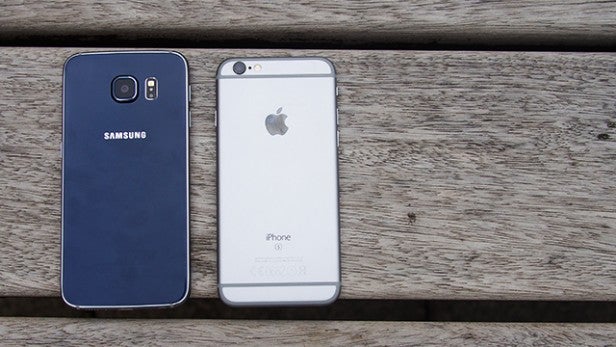
However, that glass back is an undeniable weak point in terms of practicality. It’s excessively slippery and undeniably shatter-prone.
In terms of practical day-to-day usage and ruggedness, we have to give the iPhone 6S and its all-metal construction the nod – particularly with those reinforcements. And THAT’s not something we would have imagined saying 12 months ago either.
The iPhone 6S is also the easier phone to hold, thanks to its smaller size and metal back. The Galaxy S6, by contrast, is a slippery little sucker thanks to its glass back. Don’t even think of laying it down on a slightly angled, non-grippy surface, as it has the tendency of sliding off with minimal provocation.
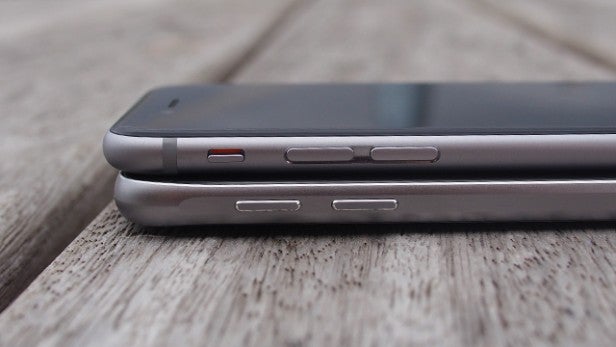
iPhone 6S vs Samsung Galaxy S6: Screen
iPhone 6S: 4.7-inch, 1334 x 750 IPS LCD, 3D Touch
Galaxy S6: 5.1-inch, 2440 x 1560 ‘QHD’ Super AMOLED
The iPhone 6S display is very similar indeed to the iPhone 6’s. That means a 4.7-inch IPS LCD display and no gorgeous QHD display that’s currently packed into the S6.
We loved this display in the iPhone 6, and we still love it in the iPhone 6S. It’s perfectly sized for one-handed usage, without being restrictive like previous 4-inch iPhones. At that size, too, the iPhone’s 1334 x 750 resolution is just sharp enough. It’s also extremely bright and vivid.
While there’s no change in the resolution stakes, where the iPhone 6S display does get an improvement is in its functionality.
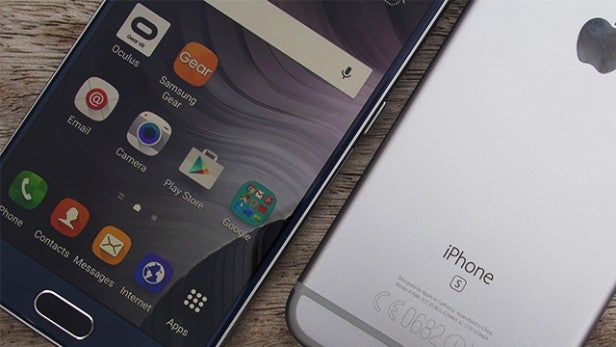
Apple has added 3D Touch to its smartphone range after successful (if tentatively applied) showings in the Apple Watch and New MacBook. This new technology recognises the amount of pressure you place on the display, literally enabling an extra layer of depth to touch inputs.
We found this technology to be much more than just a gimmick, with lots of handy little applications dotted throughout iOS 9, such as the ability to preview emails and websites, or jump straight to the selfie cam. It’s only going to get more useful as more and more developers add 3D Touch support, too.
The Samsung Galaxy S6 has no such pressure-sensing technology, but as a pure display, it’s touch to argue that it still isn’t flat out superior to the iPhone 6S’s. Yes, its QHD resolution is much sharper than the iPhone’s, but that’s the least of its feats.
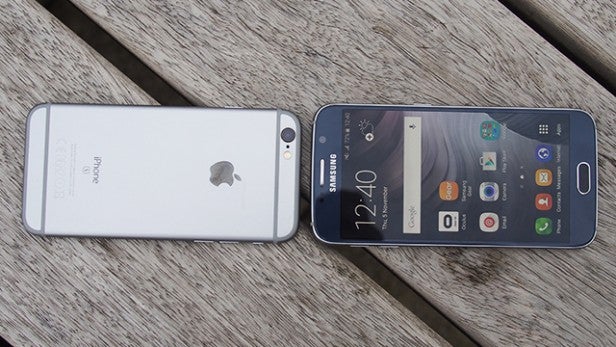
Samsung’s supreme grip on Super AMOLED technology means it’s more vibrant, with deeper blacks and higher contrast.
If you care about somewhere to watch video and browse the web, the S6 is a cut above the iPhone 6s, but that’s not to say that Apple’s latest phone isn’t accomplished in these areas.
Put simply, the iPhone 6S display is smarter, but the Samsung Galaxy S6 screen is better looking.
- Buy now: iPhone 6S (12GB) on O2 for £32/month
- Buy now: iPhone 6S (20GB) on O2 for £35/month
Related : What can 3D Touch do on the iPhone 6S?
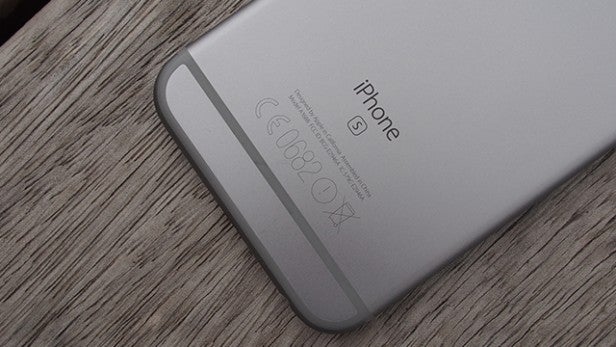
iPhone 6S vs Samsung Galaxy S6: Power
iPhone 6S: Apple A9 64-bit dual-core CPU, 2GB RAM
Galaxy S6: Exynos 7420 64-bit octa-core, 3GB RAM
The iPhone 6 impressed with its potent 64-bit A8 CPU, which as always blew away the off-the-shelf Android competition on single-core performance – still incredibly important for mobile usage.
However, the Galaxy S6 came along with Samsung’s own Exynos 7420, an octa-core chip that blitzed the A8 on multi-core performance and got surprisingly close on single-core terms. At the time of its launch, it was pretty much the best mobile SoC (System on Chip) around.
So what of the iPhone 6S? Well, it runs on the A9 chip, which is significantly faster than the A8 in both CPU and GPU departments. We’re talking around 70 percent faster on the CPU front, and 90 percent faster on the GPU front.
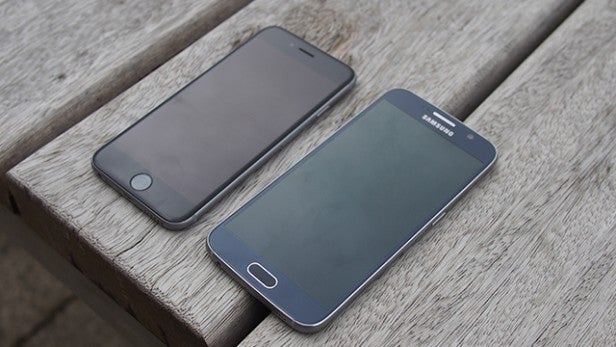
It gives the Galaxy S6’s Exynos chip a serious run for its money. In terms of single-core performance the A9 blitzes the Galaxy S6, while the Galaxy S6 only pips the iPhone 6S by a small amount on the multi-core benchmarks.
Things get interesting when we turn to RAM. The Galaxy S6 has a generous 3GB, while the iPhone 6S has 2GB of RAM.
The S6 appears to have the edge on the RAM count, but it’s worth mentioning that iOS is renowned for being much easier on the RAM than Android. In actual fact, the iPhone 6S doubles up on the memory of previous iPhones, making for a dramatic performance increase. It’s noticeably quicker than the iPhone 6.
It’s also worth mentioning that the iPhone 6S comes with a new and improved version of Touch ID, which loads up much faster than before. We’d even say that it feels faster than the Galaxy S6 equivalent, although we don’t have any complaints with either.
Related: Octa-core or Quad-core? does it make a difference?

iPhone 6S vs Samsung Galaxy S6: Camera
iPhone 6S: 12-megapixel rear camera, f/2.2 aperture, dual LED flash, 4K video recording
Galaxy S6: 16-megapixel rear camera, f/1.9 aperture single LED flash, OIS, 4K video recording
Apple has had the smartphone camera market all but sown up in recent years – until the launch of the Samsung Galaxy S6. Here for the first time Samsung provided a camera that topped its great rival’s effort in many people’s estimations.
Naturally, Apple looked to redress the balance with the iPhone 6S. It did so by bumping up the megapixel count for the first time since the iPhone 4S, with a new 12-megapixel image sensor. Up front is a 5-megapixel Retina HD with Retina flash that uses the entire phone screen to capture your mug.
The rear camera technically still trails the 16-megapixel Galaxy S6, but we’ve all realised that more doesn’t necessarily mean better in image sensors of this size, haven’t we?
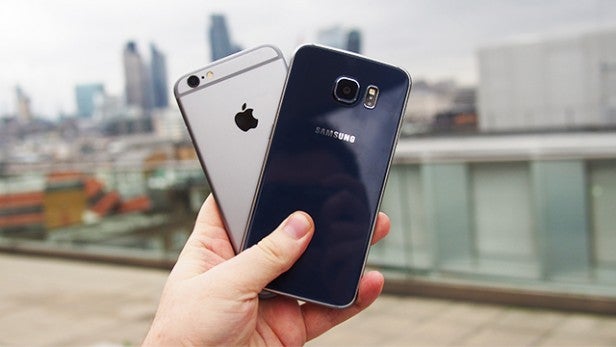
One disappointment with the new iPhone 6S camera is the lack of OIS (optical image stabilisation). One of the reasons the iPhone 6 omitted the shot-steadying technology while the iPhone 6 Plus included it is because the smaller phone was too thin and sadly the handy feature for improving low-light photography misses out again.
The S6 has a lot going for it beyond more megapixels and OIS, of course. It’s very fast to take a shot, which is helped by its splendid home button-based camera shortcut. It also has an excellent Pro manual mode, which Apple’s iPhone range still lacks.
The Galaxy S6 also has a wider aperture f/1.9 lens than the f/2.2 iPhone 6S, which lets more light in and helps with low-light shots, as well as in capturing that lovely defocused background, or bokeh, effect.
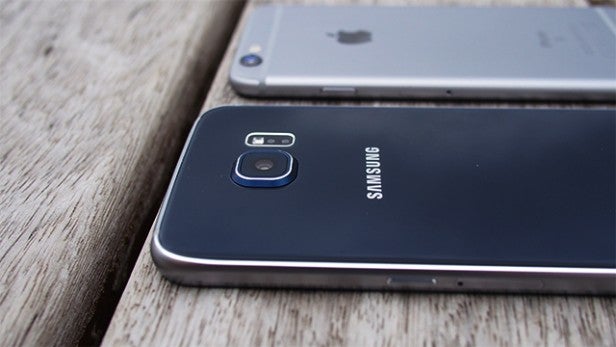
Overall, we can’t call which camera is better. The iPhone remains the best phone for just pointing and shooting, and you’ll get more consistent results from it. But the Galaxy S6 offers greater manual control and superior low-light shots.
iPhone 6S vs Samsung Galaxy S6: Software
iPhone 6S: iOS 9
Galaxy S6: Android 5.1 Lollipop with TouchWiz UI
The iPhone 6S continues Apple’s dominance of Samsung on the software front. We’re big fans of Android 5.1 Lollipop in its unadulterated form, but Samsung does insist on tinkering with it.
Yes, the Galaxy S6 is much better in this regard than previous efforts, but it’s still inferior to plain old Android. Samsung’s efforts at differentiation serve to make any iPhone, with its uniform iOS operating system, look and feel a little classier by comparison.

You might argue that iOS hasn’t fundamentally changed enough from its original simplistic app icon-led origins. iOS 9 doesn’t change that perception, as it’s a largely iterative improvement over iOS 8.
But it certainly feels more cohesive and faster than Samsung’s Android-with-TouchWiz. Plus, in recent years, Apple has caught up with Android’s core feature count in recent years (largely through aping Google’s work).
The whole app thing is less of an issue than it’s ever been, but it’s still undeniable that the App Store is a more vibrant, higher quality offering than the Google Play Store.
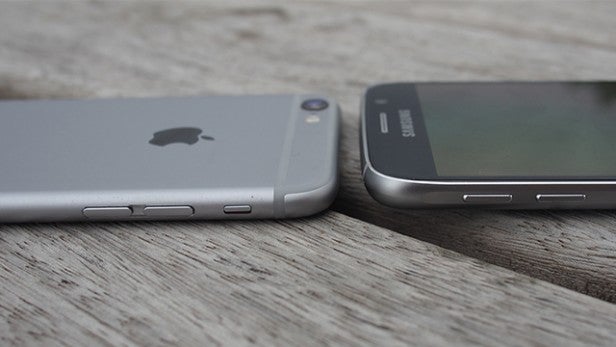
Samsung does have its own voice assistant to try and take on Siri. It’s called S Voice, and there’s plenty the voice assistant is capable of doing. From simple things like calling a number or adding events to calendars, it can update your social networks and even write a memo.
You do of course have the benefit of Google Now as well, which is soon to be upgraded with Google Now on Tap. Indeed, Google Now is a far better rival to Siri than S Voice. In fact, we’d argue that Android’s assistant has been better than Apple’s for some time now.
Apple has improved Siri considerably in iOS 9, though, and it now achieves something approaching parity. A swipe right from the main homescreen takes you to a new Siri screen, providing frequently used contacts and apps, and relevant news stories.
Siri’s voice-activated element has also grown more sophisticated, with room for naturalistic requests like ‘show me pictures taken in Australia,’ while Spotlight also pulls in search results from third party apps.
Related: Samsung Galaxy S6 vs S6 Edge

The Verdict
When we last pitched the Samsung Galaxy S6 against the iPhone 6, the Samsung just about came out on top. It’s a phenomenally good smartphone.
Now that the iPhone 6S is with us, things have evened out, and we could even be looking at a marginal iPhone 6S win.
Apple has made improvements to the iPhone 6S’s build quality at a time when we’re realising that Samsung’s heavy use of glass in the Galaxy S6 was a little ill-considered. It’s also improved the camera considerably, to the point where we prefer it as a reliable point and shoot (though the Galaxy S6 camera has its own strengths).
We were taken aback, too, by the performance gains made by the iPhone 6S. Everything from getting into the phone with Touch ID to juggling multiple web tabs and apps just feels quicker and more fluid than before. With the Galaxy S6’s heavy software weighing an otherwise capable phone down (especially with prolonged use), it’s another win for the iPhone 6S.
Conversely, Apple hasn’t done anything to improve the quality of the iPhone 6S’s screen. Not that it’s bad as such, but the Galaxy S6’s display is better in almost every way.
Almost, but not all. The real clincher here is the iPhone 6S’s 3D Touch facility. This bold new pressure-sensitive screen technology looks set to be hugely influential on future smartphone interfaces. Right now, it makes the already rapid iPhone 6S even more fluid to use.
Things have see-sawed back Apple’s way with the iPhone 6S. We’re expecting Samsung to respond in similar fashion with the Samsung Galaxy S7.
(Apester:56b8b929180dad85056cdc9c)
iPhone 6S or Galaxy S6? Let us know which you would pick in the comments below


